Description: War Thunder is a next generation military MMO game dedicated to...

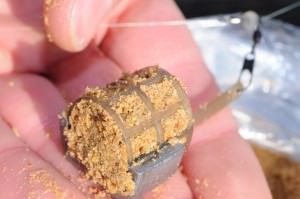
How to catch carp?
Crucian carp is a rather prolific fish and is able to survive in almost any, even extreme conditions. That is why it is most common in our reservoirs. In this article we will tell you how to catch a crucian with a bait and describe some of the most effective ways from experienced anglers.
Reservoirs in which you can catch crucian carp can be divided into 2 types:
To catch big crucian, you need to take with you several options for bait. The fact is that in different reservoirs crucian carp can peck at different bait. Therefore, take white bread, worms and some other insects with you. Also, do not forget sunflower oil in order to lubricate pieces of white bread, as some crucian carp bite very well on such a bait. Now let's look at baits in more detail.
First, let's talk about what and how to catch a large crucian. To catch large carp, you need to use large worms. The fact is that small fish simply cannot swallow a large worm (for example, crawling out), so only large crucian carp will fall on your bait.
We talked about bait, now again about reservoirs. If we talk about the reservoirs of the first type, in which only carp are found, then everything is clear. But in mixed-type reservoirs, in which other types of fish are found, including predatory fish, everything is somewhat more complicated. It is not enough to calculate the crucian path, you also need to find out the time at which the crucian goes to feed. Therefore, success in these two tasks almost certainly guarantees you a good catch.
It is best to catch crucian on a float rod and come to the place about 1.5-2 hours before the start of the bite, in order to slowly prepare bait, lure the place and collect gear. There is another complication here. The fact is that crucian carp will not show interest in a baited place for a long time. Therefore, if the flock loses interest in the baited place, you will have to wait again.
Some novice anglers make one blunder: if crucian carp stop pecking, they reinforce the bait with more powerful flavors. In this case, the flock will be frightened and lose interest in this place for a long time.
So we explained to you how to catch crucian correctly. If some questions remain unanswered, you can watch a video on how to catch crucian carp and other fish.
The arrival of spring for many anglers is associated with the beginning of carp fishing. This fish wakes up after hibernation, actively looking for food and feed, trying to restore strength. Therefore, fishing at this time of the year is interesting and exciting, and a good catch largely depends on the right gear, bait and many other nuances.
For a successful catch, it is necessary to take into account many factors that affect the bite of crucian carp in the spring.
To catch crucian carp in the spring, it is important to understand its habits, behavioral patterns and food preferences. The fact is that the end of winter, the release of water from ice, the gradual warming of water and air greatly affect the fish.
As a rule, the beginning of catching carp falls on April-May. By this time, almost all lakes and rivers have time to free themselves from ice, and the water even in deep areas warms up to 6-8 ° C.
Fishing for crucian carp in March is almost impossible. Either the ice is already so thin that it is dangerous to go out on it, or after the snow melts, there is still a large level of water.
Medium-sized crucian is the first to wake up and immediately begins to "walk". He goes to shallow water and to the coastal zone, where he can bask under the warm rays of the sun passing through the water surface, and also find food for himself. Large individuals are in no hurry to leave their places of hibernation (deep pits, dumps, etc.). Only when the water warms up to 10-12 ° C do they finally wake up.

In early spring, small individuals begin to peck first.
In early spring, crucian carp have a great need for protein and proteins, which it needs for the rapid maturation of caviar and milk. Therefore, it is better to catch on animal baits. This is a worm, maggot, caddis larva.
On many reservoirs, such a bait as a bunch of bloodworms is much more effective. It's just that mosquito larvae are the main food supply for this fish in many ponds and lakes. Therefore, the bloodworm turns out to be more familiar and familiar food, which, moreover, is easier to swallow for crucian carp, exhausted after the winter.
Catch on vegetable baits, especially in early spring, do not best idea. At this time, crucian extremely rarely pecks at pearl barley, bread or dough. Even if you treat such baits with flavors and attractants, he is unlikely to be interested in them. It is best to use vegetable nozzles in May and closer to summer. A small carp, which often has time to spawn by this time, can be tempted by semolina or fragrant dough.
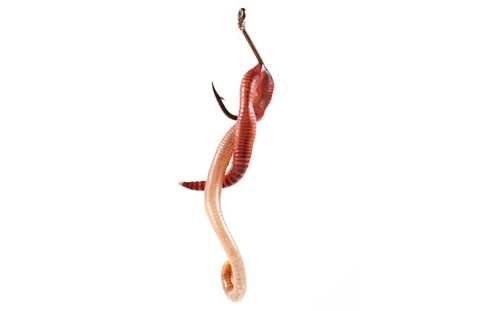
Animal baits are best suited for catching carp in early spring.
To catch carp well in early spring, we recommend using a float rod. In addition, it is best to catch near the shore, so set aside donkeys or a feeder for the summer. Pick up tackle that is not too long - from 4 to 6 m. You can use a telescopic fly or plug rod. The advantage of the latter is that it consists of two knees and is more durable. The minus of the “telescope” is that it often folds up while playing the fish, causing some inconvenience.
The equipment of the float gear should be sensitive and light. Therefore, give preference to good quality fishing line with a cross section of 0.1 to 0.15 mm. A thicker monofilament can scare away fish, because fishing in the spring most often takes place at shallow depths, where even a thin braid is quite noticeable. Hook size - No. 10-12. Both a small crucian and a large individual can swallow them.
Choose a float weighing about 1 gr. Therefore, a half-gram shot is suitable as a sinker. Some anglers do not enclose tackle at all. It is better to reduce the number of leashes to one. The fact is that in the spring you often have to catch crucian carp in overgrown areas, in snags and other hard-to-reach places, where an additional hook will increase the chances of a hook.
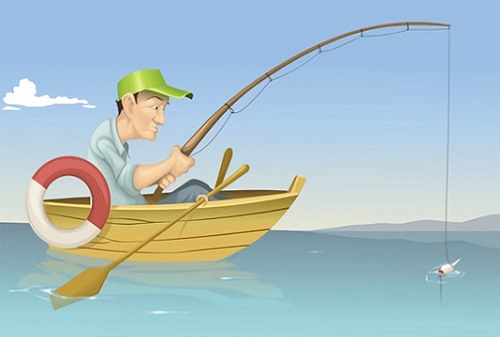
A properly equipped float rod is the best option for spring fishing for crucian carp
For fishing in the spring, make the leash on the float rod a little shorter than usual. It is enough that its length is 5-7 cm. Do I need a spinning reel for such gear? controversial issue. On the one hand, it makes the tackle heavier. On the other hand, when a large fish bites, it helps with fighting.
Taking a float rod, various lures and everything you need for fishing in the spring, every angler thinks about how to choose the best place fishing. To do this is not so difficult.
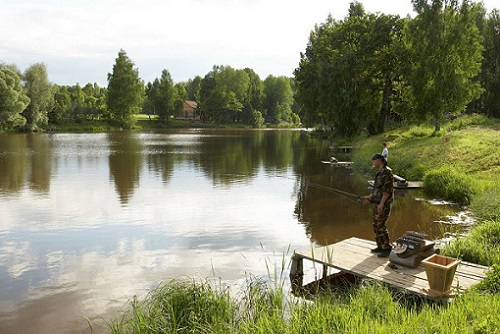
Catch carp in the spring effectively close to the shore
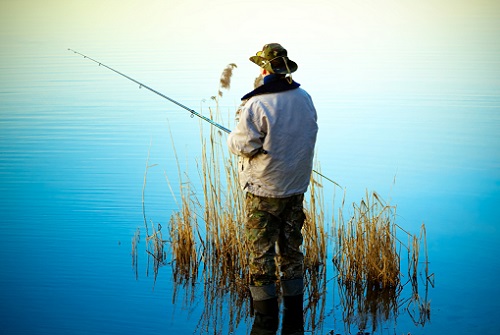
The catch depends on the correctness of the chosen place.
Catching carp in the spring with a float rod requires special skill, compliance with certain rules, etc. This is the only way to please yourself with a good catch.
First, you need to catch during the day, when it gets noticeably warmer. In the morning and evening hours, the water temperature drops, and crucian carp just stand there, not interested in the bait. In the daytime, the sun warms up shallow water well, so the fish become more active.
Secondly, it is often necessary to change the place of fishing in search of crucian carp. As we said above, in spring, fish constantly migrate following the streams of warmer water. Therefore, finding the current carp camp is not always easy. Even high-quality and balanced complementary foods do not help. Often, on the contrary, after feeding a little, even weak bites stop.
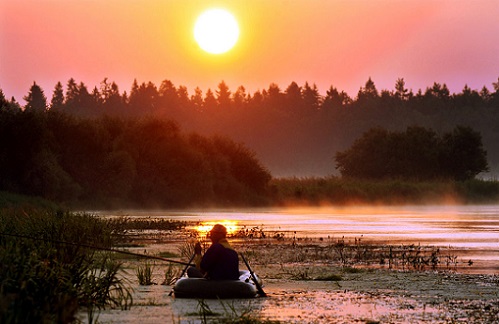
In the spring, crucian carp are poorly caught in the evening and in the morning, it is best to fish in the daytime when it is warm
Thirdly, it has to great attention give to the weather. If in the summer a little rain and a weak wind have a positive effect on biting, then in the spring under such weather conditions the crucian carp stops eating. Therefore, choose sunny days for fishing, preferably with warm wind, which not only warms up the water well, but also saturates it with oxygen.
Fourthly, fishing for crucian carp in the spring is complicated by the fact that you have to catch on fewer baits. Many vegetable baits are ineffective due to the cold water and protein requirements of the fish. Therefore, do not forget to use flavors and attractants, try to put a “sandwich” on the hook, including white + red maggot.
About catching carp on a float will be discussed in the video:
If you want to succeed in carp fishing, you simply must know everything about the gear that you can use to catch this fish. Therefore, before you go to the pond, we recommend that you carefully study different kinds fishing. This will help not only to correctly determine the most suitable tackle for you, but also to understand its advantages and disadvantages.
For catching crucian carp in different seasons, you should choose the right gear
Many novice anglers are interested in the question of what to catch carp? There are several options. Now the most popular tackle for catching this fish is a float rod. They fish with it on any body of water (on a pond, lake, river, peat bog, etc.) for the entire period of open water. To fish with a float rod, you will need a rod, line, reel, hooks, sinker and float.
Long-distance casting tackle is also common today. These include:
As a rule, their equipment includes a feeder or sinker, which allows you to cast the bait a considerable distance from the shore. It is no longer a float that acts as a bite signaling device, but a bell, a pendulum, a nod or special electronic devices that are triggered by the movement of the fishing line and warn with a sound signal.
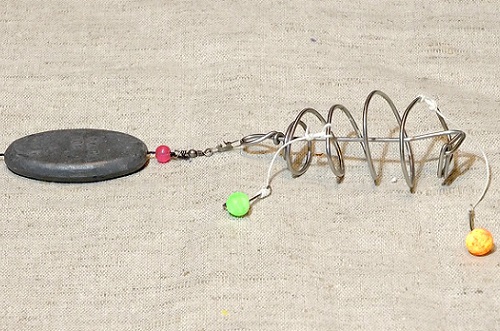
Bottom tackle is used to catch crucian carp
The crucian pecks at the mormyshka and edible rubber. Therefore, some fishermen use ultralight spinning with the slowest possible jig wiring. We will not consider various poaching methods of fishing. After all, fishing is an activity, the purpose of which is to get moral and aesthetic pleasure, and not to cause damage. environment and nature.
This tackle is used for catching carp both from the shore and from a boat. Collecting a float rod is not difficult at all. A telescopic or plug-in rod is required. Its length can vary from 4 to 12 m. If you plan to fish on an overgrown pond or from a boat, then the shortest rod (4-5 m) will do. When fishing takes place on a large body of water, it is worth taking a longer tackle, because it is quite shallow near the shore.
Optionally, an inertial coil is also placed on the float rod. However, most often anglers use a fly rod, where all the equipment is attached to the tip of the rod using a connector (special fastener).
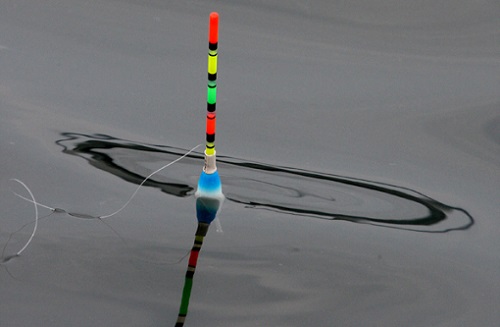
The best option for catching carp is a float rod
Equipment for float gear consists of fishing line, the optimal thickness of which is 0.1-0.14 mm. For leashes, it is taken a little thinner. It is best to choose a float weighing up to 3 grams, oblong in shape and with a long antenna. Optimal size hooks - No. 8-14. It is desirable that they have a round hook and a short forearm. The number and weight of sinkers should be minimal so that when biting crucian does not feel resistance.
On a fishing rod with a float, it is easy to catch both small and large carp. Fishing with this tackle is especially effective in the spring and in the first days of summer, when ice melts on a pond or lake, and the fish goes to the shore in search of food and in order to start spawning.
In hot weather and closer to autumn, the float rod is not always effective. This is the time when large carp peck at it less and less, because. goes into depth. Therefore, anglers try to use long-range casting tackle or a rod with a sliding rig.
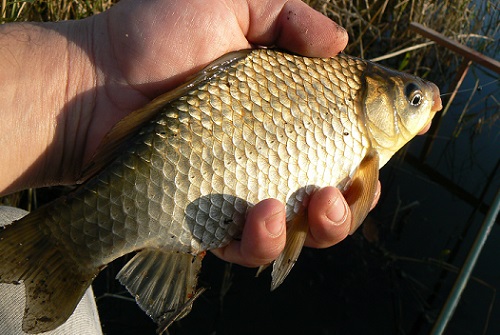
A float rod is used for catching carp, regardless of size.
The design of the feeder consists of a spinning rod with a dough of 50 gr. and a length of 2.5 to 4 m, as well as a spinning reel with a 2000-3000 spool. The spinning tip should be informative and flexible. Many even equip such a rod with a quiver tip, which acts as a nod. Another version of the bite signaling device is a bell on a special clothespin.
The main fishing line for the feeder is taken with a cross section from 0.14 to 0.22 mm. For a leader construction, it is better to use a thinner monofilament or fluorocarbon, which is practically invisible in the water. Hooks for such tackle are selected in sizes from No. 8 to No. 12. The feeder can be of any shape. The main thing is that the fishing line and the spinning test allow you to cast.
This tackle is the most popular among other donoks. The crucian regularly pecks at it, starting from spring and ending late autumn. The only caveat is that it is quite difficult to catch on the feeder during the spawning period. The fact is that the fish moves to the shore. In addition, it is simply impossible to use feeder tackle on a small overgrown pond. The equipment clings to algae, driftwood, etc.
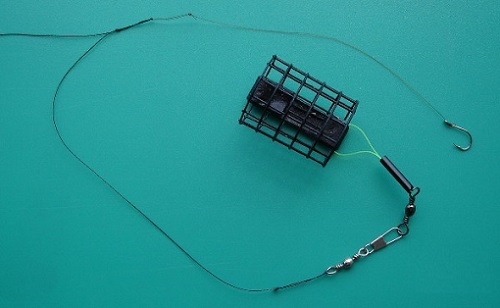
The feeder is used for catching crucian carp at a depth
In all other cases, the feeder is as efficient as possible. Especially on lakes and rivers with a large water area. Due to the feeder located next to the bait, this tackle provides a stable bite for crucian carp.
With a feeder, you can catch various parts of the reservoir, easily deliver the bait to deep pits and depressions, where there is a large concentration of fish.
You can also catch crucian on other bottom gear:
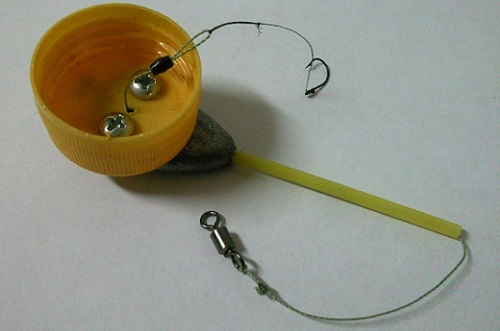
Cork tackle is effective for catching crucian carp
When catching fish and changing bait, there is no need to constantly pull out and recast tackle. Due to the rubber shock absorber, the equipment goes ashore and easily returns to its place. The most difficult thing is to install the sinker and properly mount the leashes to eliminate the possibility of tangling the fishing line. With the proper approach, the bottom tackle “elastic band” will delight you with excellent bite and a minimum number of fish coming off. After all, even a large crucian, due to a heavy load, will not be able to take the equipment into the grass or bushes in order to cut off the fishing line.
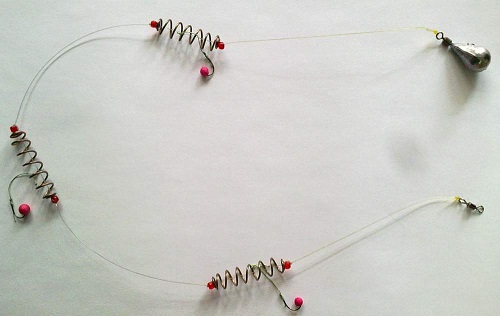
A good catch will provide tackle "crucian killer"
You can also catch crucian on a spinning tackle, if a small wobbler or twister acts as a bait. The main thing is that the equipment is properly arranged. That is, there would be a load weighing 10-15 grams, which would put the bait almost to the bottom. True, this method of fishing cannot be called productive. Crucian most often bites on spinning by accident, delighting those anglers who went for predatory fish.
A fishing rod with a side nod is another tackle for catching crucian carp. It consists of a flexible and light rod, equipped with a fairly long nod, a reel, a fishing line (braid is better) and a mormyshka. Such gear is most effective in the spring and with the active movement of the fisherman throughout the reservoir. Especially successfully you can catch with a fishing rod with a side nod in shallow areas overgrown with grass and reeds.
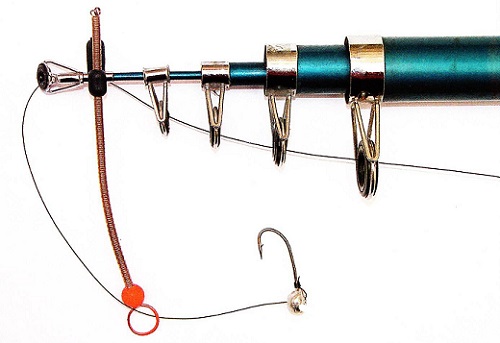
On reservoirs with frequent movement of crucian carp, a fishing rod with a side nod will be indispensable
It is not enough to know what gear is used for crucian fishing. It is also important to be able to determine which method of fishing will be more effective in a particular place, at a particular time of the year or day. Even experienced anglers sometimes do not take into account the specifics of a reservoir or calendar. As a result, the catch does not please them at all.
Therefore, when you have chosen a place where to catch crucian carp, then immediately pay attention to its features. If this is a small and overgrown pond, along the banks of which there are a lot of tall bushes and grass, or fishing will take place from a boat, then it is best to opt for a float rod.
The same goes for fishing in the spring or early summer. A float rod at this time is more catchy than any long-distance casting tackle. This is due to the fact that crucian carp moves very close to the shore, to reeds and snags, among which it can find more food, bask in warm water and lay eggs.
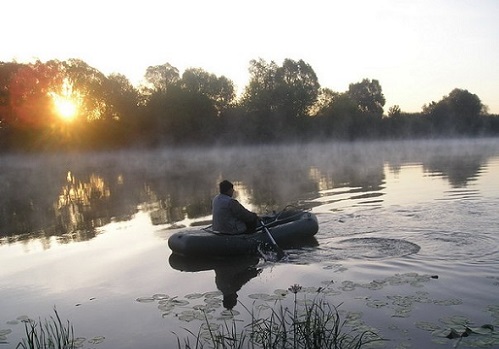
If you catch carp in the morning or in the evening, then a float rod is best suited for this.
In addition, in the morning and late evening, he also bites better on a float rod. Especially in summer and early autumn, when the weather is warm and sunny. The fish goes in search of food mainly in the morning and at sunset, and practically ceases to be active during the day.
For fishing on medium and large stagnant lakes, full-flowing rivers, it is better to use bottom gear over the course. When the depth in the reservoir is not more than 2-3 m, then the feeder shows itself well. You can also fish with cork and rubber bands in places with greater depth. The main thing is to carefully study the bottom topography in order to avoid hooks and breaks in the equipment against snags, bushes, algae, etc.
In the middle of summer and towards the end of autumn, bottom gear is more useful. Due to heat, low oxygen content in water, etc. crucian often lives at depth and away from the coast. Fishing with fly rods rarely provides a good bite, while donkeys, on the contrary, allow you to catch the places of the current fish stop, delighting with frequent bites.
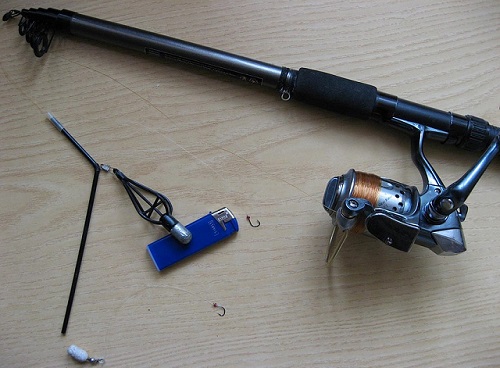
Bottom tackle is used for catching carp far from the shore.
When it is better to catch crucian on a spinning rod or a fishing rod with a side nod, not everyone knows. As a rule, this early spring and the beginning of summer. At this time, the fish are hungry and active. Carp rarely stand still, because he is busy looking for food and places to spawn. In addition, serious warming contributes to the emergence of various insects, which often fall into the water, becoming food for fish. Therefore, crucian carp is often tempted to play mormyshka or a miniature twister, which resemble a fly or a butterfly that has fallen into a pond.
Having finished talking about the gear with which you can catch crucian carp, let's move on to a discussion of what this fish is caught on. That is, what baits and nozzles are better to use? What determines their choice? How can you improve the bite and more. others?
Standard baits for crucian carp are dung or earthworm, maggot, bloodworm. In fact, they can catch this fish all year round. Motyl has proven itself well in winter fishing. Worm and maggot - in early spring, when crucian carp have a great need for protein food. Can be used as bait for larvae of caddisfly, mormysh (small crustacean), flies, grasshoppers and more. others
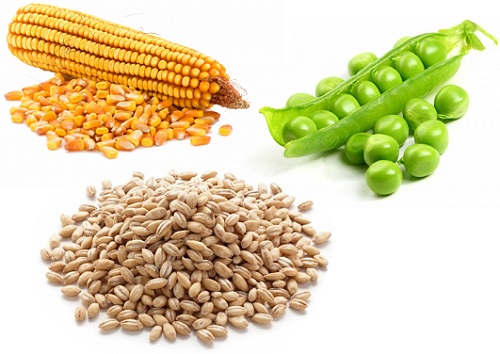
Depending on the season, crucian carp may be better at pecking at vegetable baits than at animals.
Loves carp and vegetable baits. And often he takes them well in the summer, in hot weather. The most effective are:
Some anglers catch crucian on small boilies, foam balls, painted in bright color and flavored, pieces of lard, boiled potatoes and more. others
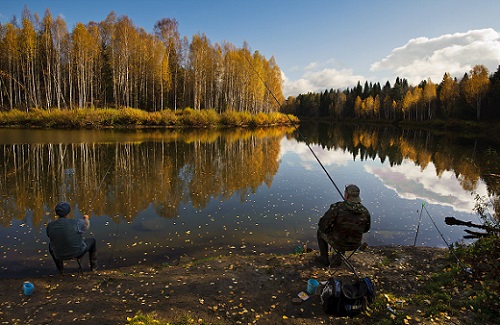
Depending on the season and place of fishing, the habits and taste preferences of crucian carp change.
It is rather difficult to guess which bait will be in great demand among fish today. Therefore, you should take several types of nozzles for fishing at once.
The taste preferences of crucian carp (especially large ones) often depend on the food base of the reservoir, season, weather conditions, places of fishing and many others. etc. For example, during a cold snap, as well as in spring and autumn, he begins to actively peck at animal baits. On a nozzle in the form of corn, more bites are observed at a depth, but in shallow water it is easier to interest a crucian with a hook with a bloodworm or a caddis larva. On a hot summer day, crucian carp can peck only on batter or fragrant talker.
From the video you will learn how to make your own crucian killer tackle:
May is over, the most important month in life for the inhabitant of almost all ponds, lakes and rivers - crucian carp. Summer is coming - the time to restore strength after spawning and gain weight for the next winter.
But many fishermen complain that fishing for crucian carp in June is unpromising, even the saying "June - spit on fishing" was allegedly invented because of our picky. Let's understand the features of summer crucian fishing.
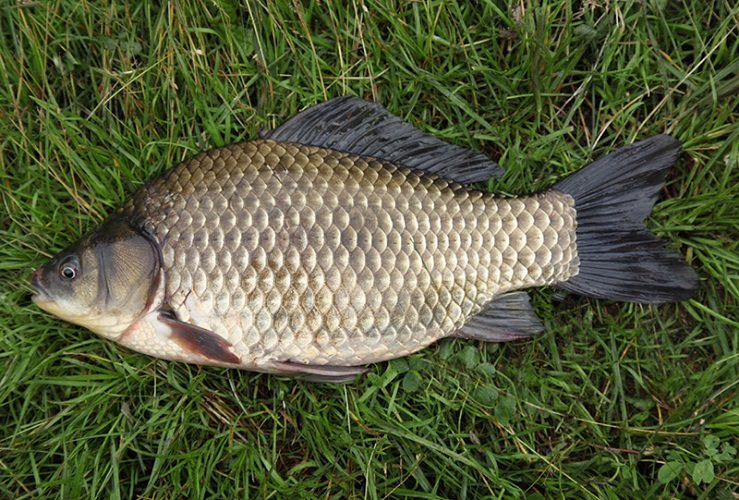
Let's try to find crucian carp in various summer months, for this we analyze his habits and features of life in different periods. Our division by months is conditional, because in different regions of a huge country the climate is also heterogeneous. Rather, it characterizes the weather conditions on the reservoir.
Indeed, all fish after spawning rest for some time, and in many regions the post-spawning period of our hero really falls on the beginning of June. And still, catching crucian carp in the summer at this time is possible, you just need to take into account a few features:
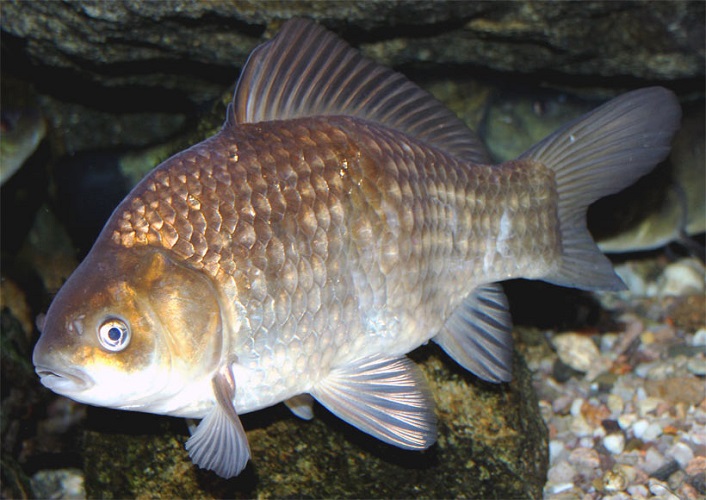
Further heating of the water forms in stagnant reservoirs, where we are mainly used to catching silver beauty, a thermocline - stratification of water into horizons with different temperatures.
Therefore, fishing for crucian carp in July will be successful if you conduct reconnaissance of the reservoir. To do this, it is not necessary to dive into the water to measure the temperature with your skin or throw a thermometer. It is enough to conduct a series of test casts at various distances and depths. It happens that the catch point is very close to the shore, and sometimes it is on the far edge.
The fastidiousness of crucian at this time reaches its peak. In the evening, he takes one bait, in the morning - another, after three hours, the sunrise field - goes to the third. To please the underwater gourmet and catching crucian carp in the summer was successful, you need to take several types of baits and nozzles with you.
Carp in August continue to actively move around the reservoir and feed plentifully. Due to the cooling of the water and the destruction of the thermocline, their parking areas become more pronounced and constant during daylight hours. These are such places in the reservoir as:
The peculiarity of August is that for peaceful fish this is last month real fattening. With the onset of autumn cold weather, aquatic vegetation dies off, and underwater microorganisms cease their vital activity, as a result, the supply of natural food decreases.
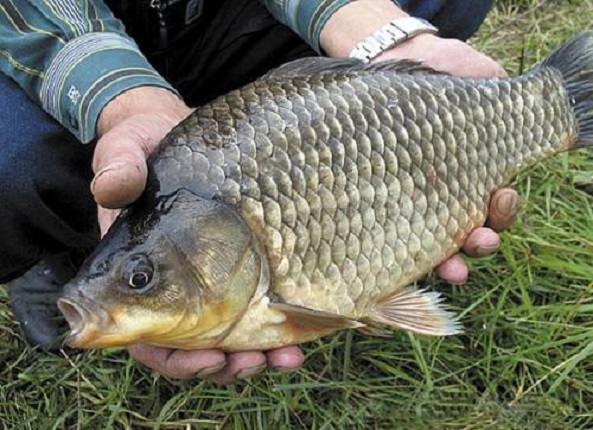
Fishing for crucian carp in August is usually very successful, at this time excellent specimens of this fish peck, sometimes trophies reach a weight of a kilogram or more, which is a very good indicator for crucian carp.
All summer long, crucian carp can be caught with both float and bottom gear, for example:
Crucian in the summer is responsive to both bait and bait. It has been noticed that constant fishing in a baited place increases the catchability many times over. Various branded and home-made dry mixes are used as bait, and various cereals are also cooked.
For catching crucian carp, it is very important to use bait as one of the bait components.
Let's imagine two recipes for bait for crucian carp in August, however, they are also applicable in early summer. Both compositions from the author.
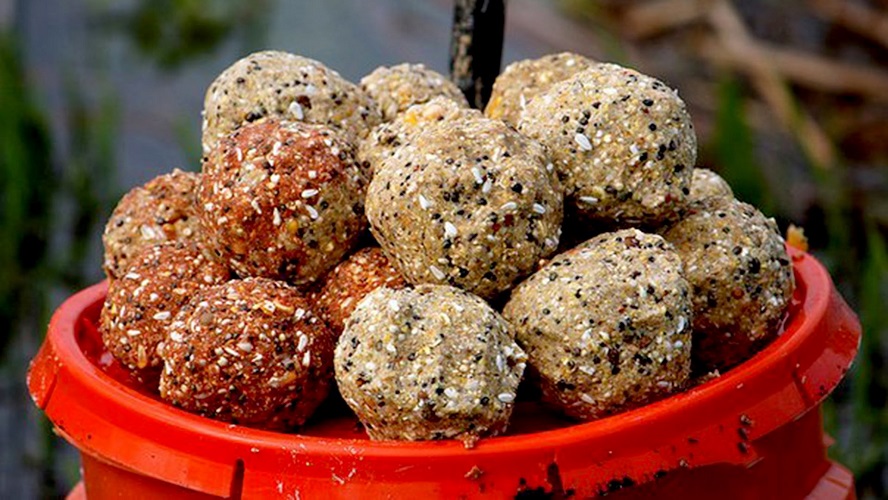
We give the proportions of the mixture approximately, it happens that there is no component of the house, we replace it with another.
In the pond, add water to the desired consistency: at the same time, the bait ball is molded well, but crumbles when pressed lightly. For such a mixture, you do not even need flavoring. Enough sunflower scent.
This version of the bait was born under the influence of the famous "salapinka", but for catching carp in August it had to be slightly modernized.
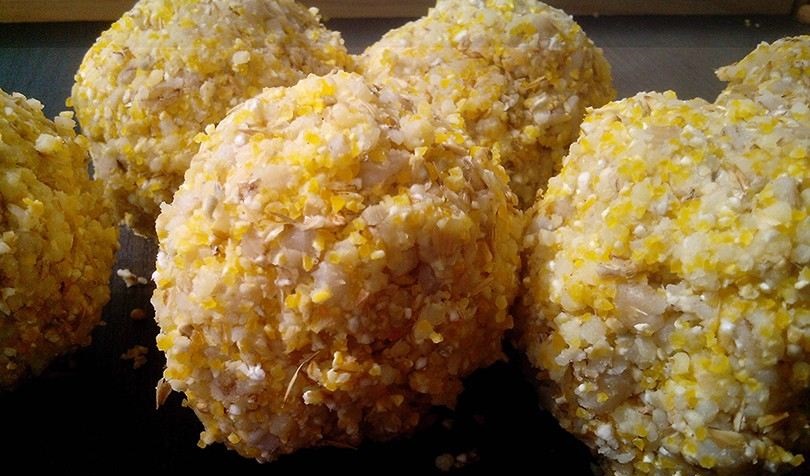
In the pond, mix the resulting bait again and supplement it with breadcrumbs. If we plan to fish with a float rod and feed with balls, we use half of the store package, for feeder fishing - the entire package.
This article will focus on fishing, perhaps the most frequent inhabitant of the fisherman's cage, crucian carp. You will learn how to catch this inhabitant of the depths with: a float rod, a feeder, a spring, an elastic band, a killer tackle, and at the end of our story you will find a pair for yourself good advice.
First of all, it is necessary to clarify that crucian carp is gold and silver. Gold - lives in lakes and swamps, and silver - lives in running waters as well.
Spring. It is best to go out for crucian carp in the pre-spawning period. In the southern regions, crucian spawns in May, in the northern regions, our almost mustachioed friend prefers to spawn in June, at a water temperature of 15 degrees Celsius. When the water reaches a temperature of 14 degrees Celsius, our species of fish begins pre-spawning zhor, this is the most optimal time for catching crucian carp.
As mentioned above, the peak of crucian activity occurs in the middle of spring - in southern regions, and the beginning of summer - in the northern regions. During the spawning season, crucian gathers in larger group. But even before spawning, it stays in flocks.
It should be noted that fishing for crucian carp in spring differs from summer by the following factors: in April, crucian carp will react only to the bait that will be delivered directly under the very nose of the fish; in June, you can catch crucian carp from the same place for several days in a row, provided, of course, that you are successful.
In the summer months, crucian carp are very capricious and bite intermittently. The peak of crucian biting occurs both in summer and in spring in the morning hours, when the sun is just rising and in the evening, when the heat of the day subsides. Also, a certain exacerbation of fish activity can be observed in the period a few hours before noon.
We can already say for sure - crucian does not pay attention to the daily routine and its biting mainly depends on weather conditions and temperature conditions. If the weather is hot, crucian carp will peck only at sunset, at night and at dawn.
However, there is a period in summer and spring days when the fish simply ceases to pay attention to the bait. This period varies in time throughout the day, it is definitely possible to say about it only that it is tied to the middle of the day.
Fishing for crucian carp in the summer is most successful throughout the night. Anglers do not yet know what the periods of crucian activity and periods when he does not pay attention to the bait are connected with, they are probably due to temperature regime.
Before any person who begins to join the fishing world, the question arises: what kind of tackle to catch? Below are several ways to catch crucian carp, which one to choose depends on your character, each type of fishing involves a different kind of activity and activity.
 All details of crucian fishing on the feeder are possible.
All details of crucian fishing on the feeder are possible.
At the beginning of spring, when the water has just warmed up, like no other tackle, a feeder is suitable for catching crucian carp. Since crucian carp do not like current, most likely you will be fishing on a lake or pond. Although on the same Volga, crucian carp actively goes in the spring.
For ponds, choose a short feeder rod 3-3.3 m long. Of course, it's okay if you have 3.9 m, it's just heavier, and the result in the form of a catch will be the same, just spend more effort on casting. But for major river 3.9 m is the minimum.
Monofilament fishing line 0.2-0.25 mm. For example, Salmo Feederist.
Attention: before the beginning fishing make sure that your float is loaded to the working level (at the very beginning of the tip). Otherwise, the sensitivity of the tackle will suffer greatly and you will not see light bites.
Fly fishing on a float involves a small fishing area, so in this case the bait does not need to be thrown with large balls, as with match equipment.
It is better to throw small balls into the water, and in the process of catching, periodically supplement the fishing place so that the crucian does not leave.
Match tackle involves a more complex technology of fishing. To begin with, you will need to measure the amount of fishing line to the intended parking lot of crucian carp and find the difference in depths. After the line is measured, it is fixed with a clip or marked with a marker. After that, you can proceed directly to fishing.
An article about the features of catching carp on a spring can be read. 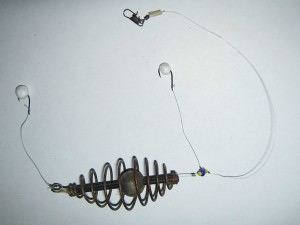 This type of fishing for crucian carp has established itself as rather expectant, but bringing success over a long distance. The method is not sports and we recommend that you pay attention to the feeder ().
This type of fishing for crucian carp has established itself as rather expectant, but bringing success over a long distance. The method is not sports and we recommend that you pay attention to the feeder ().
In order to make tackle, you will need one spring, 5 cm high and 1.5-2 cm wide.
We attach the spring to the main line, put a wide cambric on the main line and install leashes with hooks. More tackle.
For bait, it is better to use the following mixture: Moisten the crumb of white bread a little and knead until a plasticine-like consistency is obtained. Add grated sunflower seeds to the resulting mixture.
If the current in the place where you are fishing is strong, then the bait should be made more rigid, but if you are fishing in a pond or lake, then it is better to use soft bait. Before casting, dip the spring with hooks in seaweed to give it a more natural look.
As the water dilutes the bait, a cloud of appetizing haze will form in the water, and the hooks will be in the water. The crucian carp will eat complementary foods, and then stumble upon a hook and be hooked.
In cases where fishing takes place in reservoirs with stagnant water, it is very likely that crucian carp will not be able to smell the food due to the lack of current. Then all sorts of odor enhancers will come to your aid. But be careful: too strong a smell can scare away fish in cold water. Also spend more time looking for carp trails. Look for places on the surface of the water where bubbles rise, check places near the reeds.
- a fairly common type of tackle when catching crucian carp. It has some unsportsmanlike advantages and at the same time disadvantages compared to the feeder. Firstly, when fishing with an elastic band, you are freed from the need to constantly recast all the tackle, which has a positive effect on the result of fishing, since you scare the fish less. Secondly, if you use this type of gear, then the bait will always be delivered to the same place - to the place of fishing. But the presence a large number hooks makes this tackle unsportsmanlike and even banned in some reservoirs. For example, on the Volga.
For manufacturing you will need:
Manufacturing process:
The farther away from the angler the hooks are, the more firmly the bait should hold on to it. Therefore, use bread and similar loose substances on the hooks closest to you, and use worms on the farthest hooks.
If you plan to fish a small area of 30-45 m, then you can throw the tackle manually. If the fishing point is far from you, then the tackle is delivered to the fishing place by boat. When catching crucian carp, you need to attach a feeder to the insert with leashes. For your purposes, a standard feeder measuring 5 by 2 cm is suitable.
Now let's talk about choosing a place when fishing with an elastic band. If you are catching crucian carp in a stagnant pond, then in principle any place will do, the main thing is that this place does not have a flooded ravine, or another lowering of the bottom level. If you catch crucian in the river, then it is advisable for you to find a place that is overgrown with reeds. You can also find crucian carp in areas without algae among the vegetation.
Rubber lures:
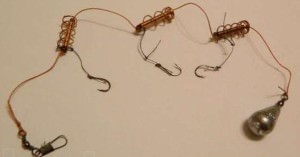 If the nearest body of water in which crucian carp is found is far from you. And you do not have the opportunity to come to the place of fishing early in the morning, or late in the evening, which requires you, then they will come to your aid. In fact, this type of fishing rod rig is an improved one. It is quite simple to make it. For one rig you will need:
If the nearest body of water in which crucian carp is found is far from you. And you do not have the opportunity to come to the place of fishing early in the morning, or late in the evening, which requires you, then they will come to your aid. In fact, this type of fishing rod rig is an improved one. It is quite simple to make it. For one rig you will need:
Step by step instructions for making:
Catching tactics. In order to determine the place where you will fish, it is better to use several rods. After the place of fishing is determined, you can proceed directly to the process of fishing. It is better to install your rod on a special one. After the cast is done and the sinker is on the bottom, make sure that the line does not sag.
When winding the line on initial stage, in order to pull the fishing line - make sure that the feeders remain in the same place, otherwise the lure will be scattered around the place of fishing.
Usually a bite looks like this: at first a jerk is visible, and then the fishing line sags sharply, at this moment do not yawn, but do not cut too sharply - the crucian has very tender lips.
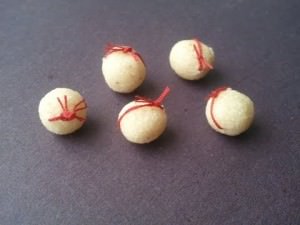
An article about all crucian baits. Carp is a very picky fish when it comes to bait.
All baits that are used when fishing for crucian carp can be divided into 2 types:
In the time of catching crucian carp, three stages can be distinguished:
As you can see, the choice of crucian carp is significantly determined by the temperature conditions of fishing. In addition, the fisherman should not forget that this type of fish is very capricious. I would like to advise a novice angler to take with him as much as possible more species bait and not be afraid to experiment.
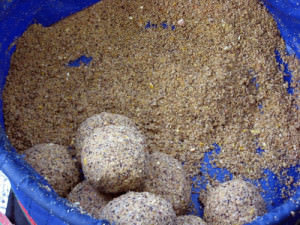
Carp are wary of light spots on the bottom, choose a dark bait
Nowadays, it is not difficult to find good bait in the store. We recommend compositions under the brands Sensas, Dunaev, Trapper with the label "crucian". And on the Internet you can buy bait at an even lower price. It is enough to visit several Internet resources.
Despite the fact that many anglers prefer their own creations, store-bought baits certainly have some advantages. These include:
And yet, no matter how good a store-bought bait is, it cannot always take into account the subtleties of the taste preferences of a particular fish in particular reservoirs. We can most often observe this phenomenon on large lakes near villages, where fish have been accustomed for years to the culture grown in the area. As bait, you can use: worms, maggots, small bloodworms, as well as various types of flour and grains (for example, corn, or peas). The recipe for one type of homemade bait will be described below.
For the preparation of complementary foods we need:
All these ingredients must be mixed with water and sand and made into small balls, which must be thrown into the place of fishing.
Why do some anglers attach a foam ball to the shank of a hook? This is done so that the hook reduces its weight and becomes the most easily sucked up for the crucian.
At what depth does the crucian keep? Crucian feeds on living creatures, which he finds in the silt, so you should look for him at the very bottom.
What to do if it doesn't bite? Firstly, all the advice in this article should be taken very responsibly. Secondly, follow the link to the manual for the type of fishing you are doing and study everything thoroughly there. And thirdly, the crucian most often chooses a special route for itself, along which it moves. If you don’t bite for a long time, then most likely you couldn’t find the crucian path and you better start looking for it.